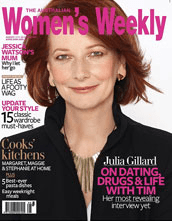The Australian Women's Weekly facts for kids

Julia Gillard on the July 2010 cover
|
|
| Editor-in-chief | Nicole Byers |
|---|---|
| Categories | Women's magazines |
| Frequency | Monthly |
| Circulation | 459,175 (2013) |
| Founded | 1933 |
| Company | Are Media |
| Country | Australia New Zealand |
| Based in | Sydney |
| Language | Australian English |
| ISSN | 0005-0458 |
The Australian Women's Weekly, often called The Weekly, is a popular magazine for women in Australia. It's published every month in Sydney by a company called Mercury Capital. For a long time, it was the most popular magazine in Australia. In 2014, another magazine, Better Homes and Gardens, became more popular. But by February 2019, The Weekly was back on top as Australia's most-read magazine.
The magazine even helped make the 2020 movie I Am Woman. This film is about Helen Reddy, a famous singer and activist. The magazine's editor, Nicole Byers, said that Helen's story was very inspiring. She also mentioned that The Weekly has shared stories of amazing Australian women for over 80 years.
Contents
The Weekly's Story: How It Began
The magazine started in 1933. It was created by Frank Packer and Ted Theodore. Back then, it came out every week. The first editor was George Warnecke. A talented artist named William Edwin Pidgeon designed many of its famous covers for 25 years.
The Weekly had two main goals. First, it wanted to be like a newspaper, with up-to-date stories. Second, it aimed to be a magazine for all Australian women, no matter their background. It wanted to focus on the whole country. George Warnecke hoped the magazine would show that Australia was getting better after the Great Depression.
The Weekly celebrated its 50th birthday in June 1983. It marked its 75th birthday in October 2008. In 1997, a company called Publishing and Broadcasting Limited (PBL) started Women's Weekly magazines in Singapore. They also launched one in Malaysia in 2000. These magazines looked like The Weekly but had local stories.
In 2012, the company that owned The Weekly, ACP Magazines, was bought by the Bauer Media Group. In June 2020, a company from Sydney called Mercury Capital bought The Australian Women's Weekly. This was part of a bigger deal to buy many magazines from Bauer Media. In September 2020, Mercury Capital changed its name to Are Media. This new company now publishes The Weekly.
How The Weekly Shaped Culture
From the 1930s to the 1980s, The Weekly was very popular. Many people across Australia read its articles and ads. This included not just women, but men too. The magazine had a big influence on what people thought about women's issues and raising children.
For example, historians have looked at old issues of The Weekly. They found that the magazine encouraged school uniforms for children. This was at a time when uniforms were not required everywhere in Australia. The magazine showed pictures of children in uniforms. This helped shape ideas about being a mother and raising kids in Australia. Even today, the magazine's stories about products, kids' fashion, and celebrity children still influence readers.
Magazine Format and How Often It's Published
The magazine usually has about 240 pages. It's printed on shiny paper, about the size of an A4 page. When it first started, it was a larger, newspaper-like size. It often has special articles about modern Australian women. For many years, it also included a TV guide that you could pull out.
In 1982, the magazine stopped being published every week. It started coming out once a month instead. The word "Weekly" stayed in the name because everyone knew it that way. The last weekly issue was on December 15, 1982. The first monthly issue came out in January 1983. When it became a monthly magazine, the TV guide was removed.
Editors of The Weekly
Many different people have been editors of The Weekly over the years. Here are some of them:
- George Warnecke (1933–1939)
- Alice Mabel Jackson (1939–1950)
- Esmé (Ezzie) Fenston (1950–1972)
- Dorothy Drain (1972–1975)
- Ita Buttrose (1975–76)
- Jennifer Rowe (1987–1992)
- Nene King
- Dawn Swain (1994–2000)
- Deborah Thomas (1999–2015)
- Julia Zaetta (2005–06)
- Robyn Foyster (2007–2009)
- Helen McCabe (2009–2016)
- Kim Wilson (2016–17)
- Nicole Byers (2017–present)
Helen McCabe was the editor from 2009 to 2016. She tried to make The Weekly better at covering news. In 2009, she hired Juliet Rieden as deputy editor. Juliet later became an editor herself. Jordan Baker, who used to write for The Sydney Morning Herald, became the news editor. In February 2016, Kim Wilson was named the new editor. In July 2017, Nicole Byers became the Editor-in-Chief.
Delicious Recipes and Cookbooks
The Australian Women's Weekly has a special Test Kitchen. It was first known as the Leila Howard Test Kitchen. It started just after World War I. Since 1965, it has been in the same building as the magazine's main office in Sydney.
In 1976, the Test Kitchen published its first "Best Ever" recipes book. This book collected the most-requested recipes from the magazine. It sold out very quickly and was printed many times.
In 2006, the Test Kitchen had a team of 16 people. These included chefs, home economists, and food editors. They all worked together to create and test recipes.
In 2012, the company that owned the magazine was sold to Bauer Media Group. The Test Kitchen still tests recipes three times to make sure they are perfect. These recipes are then published in The Weekly, Woman's Day, and in The Australian Women's Weekly cookbooks. Surveys have shown that over 90% of readers buy the magazine mainly for its recipes.

